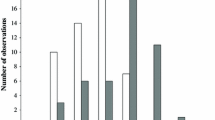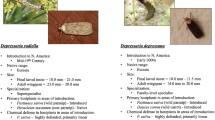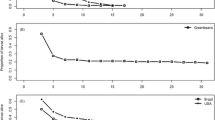Abstract
We examine the effects of the cyanogenesis polymorphism in Turnera ulmifolia on larvae, pupae, and adults of Euptoieta hegesia, the most damaging herbivore of T. ulmifolia in terms of tissue loss per unit time. We provide evidence that female E. hegesia do not show preference for host plants on the basis of their cyanogenesis level but do prefer T. ulmifolia over equally cyanogenic, closely related secondary host-plant species (Passiflora sp.). Similarly, cyanogenesis in T. ulmifolia has little effect on the food preference, growth, or development of the larvae. The potential host range of E. hegesia is limited, even within the genus Turnera, but this does not appear to be due to host-plant cyanogenesis. Pupae suffer very high mortality levels in the wild that are not associated with host-plant cyanogenesis, although our studies indicate that larvae are capable of sequestering cyanogenic glycosides from their host plants and possibly of synthesizing these or similar compounds. We provide evidence that the presence of sequestered cyanogenic compounds in the larvae protects them from terrestrial-based predators such as Anolis lizards
Similar content being viewed by others
REFERENCES
Ackery, P. R. 1988. Hostplants and classification: A review of the nymphalid butterflies. Biol. J. Linn. Soc. 33:95-203.
Baker, A. M., and Shore, J. S. 1995. Pollen competition in Turnera ulmifolia (Turneraceae). Am. J. Bot. 82:717-725.
Barrett, S. C. H. 1978. Heterostyly in a tropical weed: The reproductive biology of the Turnera ulmifolia complex (Turneraceae). Can. J. Bot. 56:1713-1725.
Barrett, S. C. H., and Shore, J. S. 1987. Variation and evolution of breeding systems in the Turnera ulmifolia L. complex (Turneraceae). Evolution 41:340-354.
Belaoussoff, S., and Shore, J. S. 1995. Floral correlates and fitness consequences of mating system variation in Turnera ulmifolia. Evolution 49:545-556.
Berenbaum, M. R., and Seigler, D. S. 1992. Biochemicals: engineering problems for natural selection, pp. 89-121, in B. D. Roitberg and M. B. Isman (eds.). Insect Chemical Ecology: An Evolutionary Approach. Chapman and Hall, New York.
Bernays, E. A., and Chapman, R. F. 1987. The evolution of deterrent responses in plant-feeding insects, pp. 159-173, in R. F. Chapman, E. A. Bernays, and J. G. Stoffolano, Jr. (eds.). Perspectives in Chemoreception and Behavior. Springer-Verlag, New York.
Bernays, E. A., Chapman, R. F., Leather, E. M., McCaffery, A. R., and Modder, W. W. D. 1977. The relationship of Zonocerus variegatus (L.) (Acridoidea: Pyrgomorphidae) with cassava (Manihot esculenta). Bull. Entomol. Res. 67:391-404.
Bowers, M. D. 1993. Aposematic caterpillars: Life-styles of the warningly-coloured and unpalatable, pp. 331-371, in N. E. Stamp and T. M. Casey (eds.). Caterpillars: Ecological and Evolutionary Constraints on Foraging. Chapman and Hall, New York.
Bowers, M. D., and Puttick, G. M. 1988. Response of generalist and specialist insects to qualitative allelochemical variation. J. Chem. Ecol. 14:319-334.
Boyden, T. C. 1976. Butterfly palatability and mimicry: experiments with Ameiva lizards. Evolution 30:73-81.
Brattsten, L. B., Samuelian, J. H., Long, K. Y., Kincaid, S. A., and Evans, C. K. 1983. Cyanide as feeding stimulant for the southern armyworm, Spodoptera eridania. Ecol. Entomol. 8:125-132.
Brinker, A. M., and Seigler, D. S. 1989. Methods for the detection and quantitative determination of cyanide in plant materials. Phytochem. Bull. 21:24-31.
Brown, F. M., and Heineman, B. 1972. Jamaica and Its Butterflies. Classey, London, 478 pp.
Brown, K. S., Jr., and Francini, R. B. 1990. Evolutionary strategies of chemical defense in aposematic bufferflies: Cyanogenesis in Asteraceae-feeding American Acraeinae. Chemoecology 1:52-56.
Brown, K. S., Jr., Trigo, J. R., Francini, R. B., Barros de Morais, A. B., and Motta, P. C. 1991. Aposematic insects on toxic host plants: coevolution, colonization and chemical emancipation, pp. 375-402 in P. W. Price, T. M. Lewinsohn, G. W. Fernandes and W. W. Benson (eds.). Plant-Animal Interactions: Evolutionary Ecology in Tropical and Temperate Regions. Wiley & Sons, New York.
Burgess, R. S. L., and Ennos, R. A. 1987. Selective grazing of acyanogenic white clover: Variation in behaviour among populations of the slug Deroceras reticulatum. Oecologia 73:432-435.
Chai, P. 1988. Wing coloration of free-flying Neotropical butterflies as a signal learned by a specialized avian predator. Biotropica 20:20-30.
Chase, M. W., and Swenson, S. M. 1995. Relationships of Violales sensu Cronquist from the perspective of cladistic analyses of rbcL sequence data. Am. J. Bot. 82:119.
Clark, A. H. 1947. The interrelationships of the several groups within the butterfly superfamily Nymphaloidea. Proc. Entomol. Soc. Wash. 49:131-140.
Compton, S. G., and Jones, D. A. 1985. An investigation of the responses of herbivores to cyanogenesis in Lotus corniculatus L. Biol. J. Linn. Soc. 26:21-38.
Cronquist, A. 1981. An Integrated System of Classification of Flowering Plants. Columbia University Press, New York, 1262 pp.
Davis, R. H., and Nahrstedt, A. 1987. Biosynthesis of cyanogenic glycosides in butterflies and moths. Insect Biochem. 17:689-693.
DeVries, P. J. 1987. The Butterflies of Costa Rica and Their Natural History. Princeton University Press, Princeton, New Jersey, 327 pp.
Dos Passos, C. F., and Grey, L. P. 1945. A genitalic survey of Argynninae (Lepidoptera: Nymphalidae). Am. Mus. Novit. 1296:1-29.
Dritschilo, W., Krummel, J., Nafus, D., and Pimentel, D. 1979. Herbivorous insects colonizing cyanogenic and acyanogenic Trifolium repens. Heredity 42:49-56.
DuQuesnay, M. C. 1971. Variation in Turnera ulmifolia L. in Jamaica. Unpublished MSc thesis. University of the West Indies, Mona, Kingston, Jamaica. 263 pp.
Ehrlich, P. R. 1958. The comparative morphology, phylogeny and higher classification of the butterflies (Lepidoptera: Papilionoidea). Univ. Kans. Sci. Bull. 39:305-370.
Ehrlich, P. R., and Ehrlich, A. H. 1982. Lizard predation on tropical butterflies. J. Lepid. Soc. 36:148-152.
Ehrlich, P. R., and Raven, P. H. 1964. Butterflies and plants: a study in coevolution. Evolution 18:586-608.
Ellis, W. M., Keymer, R. J., and Jones, D. A. 1977. The defensive function of cyanogenesis in natural populations. Experientia 33:309-311.
Faeth, S. H., Conner, E. F., and Simberloff, D. 1981. Early leaf abscission: A neglected source of mortality for folivores. Am. Nat. 117:409-415.
Feeny, P., Rosenberry, L., and Carter, M. 1983. Chemical aspects of oviposition behavior in butterflies, pp. 27-76, in S. Ahmad (ed.). Herbivorous Insects: Host-Seeking Behavior and Mechanisms. Academic Press, New York.
Feeny, P., StÄdler, E., Ahman, I., and Carter, M. 1989. Effects of plant odor on oviposition by the black swallowtail butterfly, Papilio polyxenes (Lepidoptera: Papilionidae). J. Insect Behav. 2:803-827.
Floyd, H. B., and Jenssen, T. A. 1983. Food habits of the Jamaican lizard Anolis opalinus: Resource partitioning and seasonal effects examined. Copeia 1983:319-331.
Hallman, G. 1979. Importancia de algunas relaciones naturales plantas—artopodos en la agricultura de la zona Calida del Tolima central. Rev. Colomb. Entomol. 5:19-26.
Harvey, D. J. 1991. Higher classification of the Nymphalidae, pp. 255-273, in H. F. Nijhout (ed.). The Development and Evolution of Butterfly Wing Patterns. Smithsonian Institution Press, Washington, D.C.
Johki, Y., and Hidaka, T. 1979. Function of the “warning coloration” in larvae of a diurnal moth, Pryeria sinica Moore (Lepidoptera: Zygaenidae). Appl. Entomol. Zool. 14:164-172.
Jones, D. A. 1971. Chemical defense mechanisms and genetic polymorphism. Science 173:945.
Jones, D. A. 1988. Cyanogenesis in animal-plant interactions, pp. 151-176, in D. Evered and S. Harnett (eds.). Cyanide Compounds in Biology. Wiley & Sons, Chichester, U.K.
Kirk, R. E. 1982. Experimental Design, 2nd ed. Brooks/Cole Publishing, Pacific Grove, California.
Larsen, T. B. 1992. A chameleon as predator of butterflies and its avoidance of known aposematic species. Trop. Lepid. 3:101-104.
Martin, J. A., and Pashley, D. P. 1992. Molecular systematic analysis of butterfly family and some subfamily relationships (Lepidoptera: Papilionoidea). Ann. Entomol. Soc. Am. 85:127-139.
Moermond, T. C. 1981. Prey-attack behavior of Anolis lizards. Z. Tierpsychol. 56:128-136.
Nahrstedt, A. 1988. Cyanogenesis and the role of cyanogenic compounds in insects, pp. 131-150, in D. Evered and S. Harnett (eds.). Cyanide Compounds in Biology. Wiley & Sons, Chichester, U.K.
Nahrstedt, A., and Davis, R. H. 1981. The occurrence of the cyanoglucosides linamarin and lotaustralin in Acraea and Heliconius butterflies. Comp. Biochem. Physiol. 68B:575-577.
Nahrstedt, A., and Davis, R. H. 1983. Occurrence, variation and biosynthesis of the cyanogenic glucosides linamarin and lotaustralin in species of the Heliconiini (Insecta: Lepidoptera). Comp. Biochem. Physiol. 75B:65-73.
Odendaal, F. J., Rausher, M. D., Benrey, B., and Nunez-Farfan, J. 1987. Predation by Anolis lizards on Battus philenor raises questions about butterfly mimicry systems. J. Lepid. Soc. 41:141-144.
Owen, D. F., and Smith, D. A. S. 1990. Interpopulation variation and selective predation in the meadow brown butterfly, Maniola jurtina (L.) (Lepidoptera: Satyridae) in the Canary Islands. Biol. J. Linn. Soc. 39:251-267.
Peterson, S. C. 1986. Breakdown products of cyanogenesis: Repellency and toxicity to predatory ants. Naturwissenschaften 73:627-628.
Raubenheimer, D. 1989. Cyanoglycoside gynocardin from Acraea horta (L.) (Lepidoptera: Acraeinae): possible implications for the evolution of Acraeine host choice. J. Chem. Ecol. 15:2177-2189.
Rausher, M. D. 1979. Larval habitat suitability and oviposition preference in three related butterflies. Ecology 60:503-511.
Renwick, J. A. A. 1989. Chemical ecology of oviposition in phytophagous insects. Experientia 45:223-228.
Rohlf, F. J. 1984. BIOM, A Package of Statistical Programs. Published by the author, Ecology and Evolution, SUNY, Stony Brook, New York.
Roughgarden, J. 1995. Anolis Lizards of the Caribbean: Ecology, Evolution and Plate Tectonics. Oxford University Press, New York, 200 pp.
SAS. 1996. SAS/STAT User's Guide, Release 6.11. SAS Institute, Cary, North Carolina.
Schappert, P. J. 1997. Studies of the cyanogenesis polymorphism in Turnera ulmifolia L. (Turneraceae) and its interaction with the butterfly Euptoieta hegesia Cramer (Nymphalidae) on Jamaica. PhD dissertation. York University, North York, Ontario, Canada.
Schappert, P. J., and Shore, J. S. 1995. Cyanogenesis in Turnera ulmifolia L. (Turneraceae). I. Phenotypic distribution and genetic variation for cyanogenesis on Jamaica. Heredity 74:392-404.
Schappert, P. J., and Shore, J. S. 1998. Ecology, population biology and mortality of Euptoieta hegesia Cramer (Nymphalidae) on Jamaica. J. Lepid. Soc. 52:9-39.
Schappert, P. J., and Shore, J. S. (in press) Cyanogenesis, herbivory and plant defense in Turnera ulmifolia on Jamaica. Ecoscience.
Scriber, J. M. 1978. Cyanogenic glycosides in Lotus corniculatus: Their effect upon growth, energy budget, and nitrogen utilization of the southern armyworm, Spodoptera eridania. Oecologia 34:143-155.
Seigler, D. S. 1991. Cyanide and cyanogenic glycosides, pp. 35-77, in G. A. Rosenthal and M. R. Berenbaum (eds.). Herbivore: Their Interaction with Secondary Plant Metabolites, 2nd ed., Vol. 1: The Chemical Participants. Academic Press, San Diego, California.
Sexton, O. J., Bauman, J., and Ortleb, E. 1972. Seasonal food habits of Anolis limifrons. Ecology 53:182-186.
Shore, J. S., and Obrist, C. M. 1992. Variation in cyanogenesis within and among populations and species of Turnera series Canaligerae (Turneraceae). Biochem. Syst. Ecol. 20:9-15.
Singer, M. C. 1986. The definition and measurement of oviposition preference in plant-feeding insects, pp. 65-94, in J. R. Miller and T. A. Miller (eds.). Insect-Plant Interactions. Springer-Verlag, New York.
Singer, M. C., Thomas, C. D., Billington, H. L., and Parmesan, C. 1994. Correlates of speed of evolution of host preference in a set of twelve populations of the butterfly Euphydryas editha. Ecoscience 1:107-114.
Smiley, J. T. 1983. Passiflora foetida (Bombillo, Calzoncillo, Norbo, Granadilla del Monte, Passion Flower), pp. 298-299, in D. H. Janzen (ed.). Costa Rican Natural History. University of Chicago Press, Chicago, Illinois.
Smiley, J. T., and Wisdom, C. S. 1985. Determinants of growth rate on chemically heterogeneous host plants by specialist insects. Biochem. Syst. Ecol. 13:305-312.
Smith, D. S., Miller, L. D., and Miller, J. Y. 1994. The butterflies of the West Indies and South Florida. Oxford University Press, Oxford, 264 pp.
Spencer, K. C. 1988. Chemical mediation of coevolution in the Passiflora-Heliconius interaction, pp. 167-240, in K. C. Spencer (ed.), Chemical Mediation of Coevolution. Academic Press, San Diego, California.
Spencer, K. C., Seigler, D. S., and Fraley, S. W. 1985. Cyanogenic glycosides of the Turneraceae. Biochem. Syst. Ecol. 13:433-435.
Stamp, N. E., and Bowers, M. D. 1990. Phenology of nutritional differences between new and mature leaves and its effect on caterpillar growth. Ecol. Entomol. 15:447-454.
Thomas, C. D. 1987. Behavioural determination of diet breadth in insect herbivores: The effect of leaf age on choice of host species by beetles feeding on Passiflora vines. Oikos 48:211-216.
Thompson, J. N. 1983. Selection pressures on phytophagous insects feeding on small host plants. Oikos 40:438-444.
Thompson, J. N., and Pellmyr, O. 1991. Evolution of oviposition behavior and host preference in Lepidoptera. Ann. Rev. Ecol. Syst. 36:65-89.
Tober, I., and Conn, E. E. 1985. Cyclopentenylglycine, a precursor of deidaclin in Turnera ulmifolia. Phytochemistry 24:1215-1218.
Vijayaraghavan, M. R., and Kaur, D. 1966. Morphology and embryology of Turnera ulmifolia L. and affinities of the family Turneraceae. Phytomorphology 16:539-553.
Weller, S. J., Pashley, D. P., and Martin, J. A. 1996. Reassessment of butterfly family relationships using independent genes and morphology. Ann. Entomol. Soc. Am. 89:184-192.
White, R. R. 1987. The trouble with butterflies. J. Res. Lepid. 25:207-212.
Woodhead, S., and Bernays, E. A. 1978. The chemical basis of resistance of Sorghum bicolor to attack by Locusta migratoria. Entomol. Exp. Appl. 24:123-144.
Zangerl, A. R., and Berenbaum, M. R. 1993. Plant chemistry, insect adaptations to plant chemistry, and host plant utilization patterns. Ecology 74:47-54.
Author information
Authors and Affiliations
Rights and permissions
About this article
Cite this article
Schappert, P.J., Shore, J.S. Effects of Cyanogenesis Polymorphism in Turnera ulmifolia on Euptoieta hegesia and Potential Anolis Predators. J Chem Ecol 25, 1455–1479 (1999). https://doi.org/10.1023/A:1020995329980
Issue Date:
DOI: https://doi.org/10.1023/A:1020995329980




